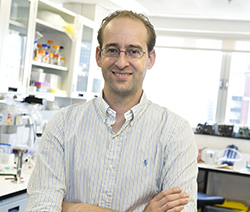Killing HIV reservoir cells—cells that are persistently infected with the virus—would potentially eradicate HIV from the body. In three journal articles published in December, amfAR-funded scientists discuss recent advances in understanding how immune system cells use antibodies to kill HIV-infected cells via antibody-dependent cellular cytotoxicity (ADCC). ADCC is an immune response in which antibodies act as homing devices to recruit immune cells that target and kill infected cells.
 Dr. Amy ChungThese advances include: developing tools to better understand antibody functionality; identifying which antibodies are most suited to ADCC; and examining their protective role against infection.
Dr. Amy ChungThese advances include: developing tools to better understand antibody functionality; identifying which antibodies are most suited to ADCC; and examining their protective role against infection.
The goal: to learn how antibodies can cure HIV.
A new tool to examine antibody function
In a study published in the journal Retrovirology, amfAR-funded scientists Drs. Amy Chung of the University of Melbourne in Australia and Galit Alter of the Ragon Institute of MGH, MIT and Harvard University in Cambridge, MA, write about a platform of techniques called systems serology, which they developed to explore the functionality of antibodies. Through this approach, which uses machine learning algorithms to analyze data on the biophysical and functional properties of antibodies, Chung and Alter can identify features  Dr. Galit Alterof HIV-specific antibodies that are better able to engage in ADCC. They hope that by using systems serology in primate vaccine studies, they can better understand how vaccines skew immune responses to protect against infection or how to improve the ADCC response in humans.
Dr. Galit Alterof HIV-specific antibodies that are better able to engage in ADCC. They hope that by using systems serology in primate vaccine studies, they can better understand how vaccines skew immune responses to protect against infection or how to improve the ADCC response in humans.
Antibodies protect non-HIV infected partners
Supported by an amfAR Mathilde Krim Fellowship, Chung is studying the mechanisms of interaction between vaccines that produce IgA, a type of antibody present only in mucosal tissues, and IgG, an antibody present in the blood, to provide partial protection against HIV. Writing in the journal EBioMedicine, she comments on a study carried out by researchers at the University of Buenos Aires in Argentina that supports her observations: the ratio of IgG to IgA correlates with the killing action of antibodies, most likely through ADCC. Furthermore, HIV-infected persons with high ratios of IgG to IgA are much less likely to transmit the virus to their HIV-free partners. She concludes that even people not infected with HIV benefit from their HIV-positive partners’ effective antibody responses.
A narrow window for antibody susceptibility in HIV-infected cells
 Dr. Andrés Finzi And in a third study published in the journal Virology, amfAR-funded scientist Dr. Andrés Finzi of the Centre de Recherche du CHUM in Montreal, reports on the susceptibility of the viral protein Env—present on the surface of actively infected cells—to antibodies. Finzi shows that Env exists in three different states: open, partially open, and closed. It had previously been thought that Env was only vulnerable to antibody attack in the open position. However, by altering the protein to lock it into a partially open position, Finzi found that it, too, was subject to antibody binding. Through this finding, Finzi has increased the options researchers have for designing antibodies to target Env and eventually eliminate HIV-infected cells through ADCC.
Dr. Andrés Finzi And in a third study published in the journal Virology, amfAR-funded scientist Dr. Andrés Finzi of the Centre de Recherche du CHUM in Montreal, reports on the susceptibility of the viral protein Env—present on the surface of actively infected cells—to antibodies. Finzi shows that Env exists in three different states: open, partially open, and closed. It had previously been thought that Env was only vulnerable to antibody attack in the open position. However, by altering the protein to lock it into a partially open position, Finzi found that it, too, was subject to antibody binding. Through this finding, Finzi has increased the options researchers have for designing antibodies to target Env and eventually eliminate HIV-infected cells through ADCC.
In conclusion, all three of these studies will provide us with the tools and knowledge we need to manipulate immune responses to harness the killing power of antibodies and cure HIV.
Dr. Flores is amfAR’s associate director of research.